
May 2021
George
Floyd’s Murderer Convicted, Police Impunity Remains
One Year After George Floyd,
Racist Killer Cops Keep Killing
Only Revolution Can Bring Justice!
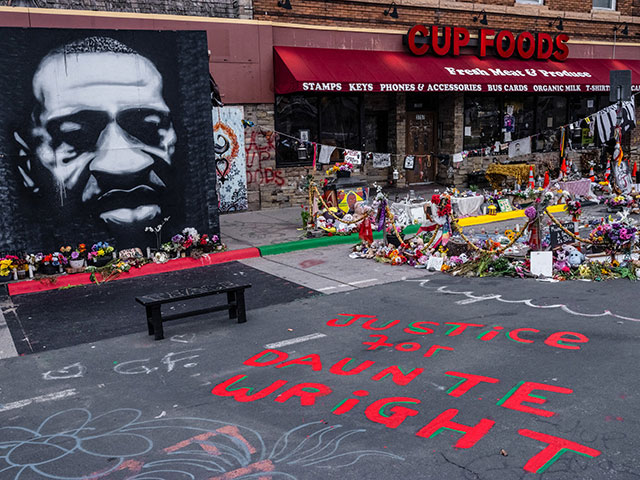
“Justice for Daunte Wright” on the street in front of the memorial for George Floyd in Minneapolis, April 12. Before, during and after the trial of killer cop Derek Chauvin, racist police terror has never stopped.
(Photo: Joshua Rashaad McFadden for The New York Times )
MINNEAPOLIS/NEW YORK, May 25 – On the first anniversary of the cold-blooded murder of George Floyd by killer cop Derek Chauvin, it is clear to all that, despite the massive protests against racist police brutality that swept the country, there has been no change in the treatment of black people at the hands of the enforcers of “law and order.” Nor, for that matter, was there any change after the original Black Lives Matters protests in 2014 following the police murders of Michael Brown, Eric Garner, Laquan McDonald, Tamir Rice and many others; or after the murder of Freddie Gray and Sandra Bland in 2015, or the murder of Philando Castile in 2016, or . . . Year in and year out, wanton police killing of African Americans, Latinos, Native Americans, Asian Americans, as well as hundreds of white working people goes on and on.
The grisly death toll tells the story. Already, in the first four months of 2021, 700 people died in encounters with police in the U.S., almost six a day, the same rate as last year when over 2,200 were killed (well above the 2000-2019 yearly average of 1,400 deaths caused by police).1 During the seven-week trial of Derek Chauvin, as the whole country was on pins and needles awaiting the outcome, 179 were killed, including 13-year-old Adam Toledo in Chicago, shot down with his hands raised the day trial testimony began. All-round racist president Donald Trump incited police killings with his incendiary rhetoric about shooting “looters,” but in the first hundred days of the administration of Democrat Joe Biden, more than 650 people died in police actions. The fact that one badge-toting killer was convicted of murder changes nothing.
Meanwhile, we are hearing a lot of earnest talk of police “reforms,” of “de-escalation” and “anti-bias” training, of changing rules on use of deadly force, improving police-community relations and the like. The Democratic House of Representatives has passed a “George Floyd Justice in Policing Act” (no Republicans voted for it, and it is going nowhere in the Senate) with a few reforms, like “incentivizing banning of chokeholds,” banning no-knock warrants in federal drug cases and lifting “qualified immunity” for police. But for all the BS about “transparency” and “accountability,” and the bill’s pious calls to “empower our communities to reimagine public safety in an equitable and just way,” none of this will make a difference. The appeals to “defund” and even “abolish the police” are gone. Today, the front-runners in the New York City Democratic mayoral primary, and in elections from coast to coast, are demanding more cops.
Racist police brutality is not a matter of a few “bad apples,” or even a barrel full. It’s not just about “police culture” and the “blue wall of silence” when it comes to “testilying” for fellow cops in court. Police impunity is built into the system, and that system is racist American capitalism. That is true even with black cops, black police chiefs, black mayors and black presidents, because the laws themselves, the political system and the whole economic and social structure are racist. Under this system, black people are 2.6 times as likely to be killed by police as whites (in Chicago 22 times as likely), and Latinos 1.5 times as likely.2 At the same time, a majority of those killed by police are non-Hispanic whites.3 While racism is key to the picture, it’s not just about race, but also class: it is overwhelmingly poor and working people whose lives are snuffed out by kill-crazed cops.4
The charade of police “reform” won’t change a thing in this country founded on black slavery and genocide of Native Americans. Today police ride herd on millions of people forced into desperation by poverty wages, housing segregation and rent-gouging, inadequate and discriminatory health care and all the other social pathologies of the decaying profit system. The police “serve and protect” the interests of capital. To put an end to the systemic racism they enforce, the only solution is socialist revolution. To see why, you only have to look at liberal Minneapolis, Minnesota, where almost every police “reform” in the book was already tried before killer cop Chauvin squeezed the life out George Floyd with a knee to the neck.
A Carefully Choreographed Trial
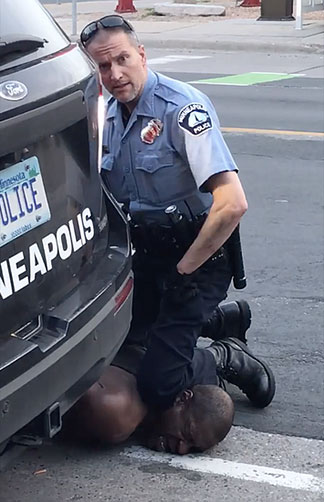 Minneapolis cop Derek
Chauvin as he murdered George Floyd with a knee to the neck.
One racist killer cop is convicted, more than 13,000 go free.
It's a system: racist American capitalism. (Photo: screenshot from Daniella
Frazier video)
Minneapolis cop Derek
Chauvin as he murdered George Floyd with a knee to the neck.
One racist killer cop is convicted, more than 13,000 go free.
It's a system: racist American capitalism. (Photo: screenshot from Daniella
Frazier video)During the weeks of jury selection and trial testimony, the bourgeois media gave a play-by-play account. Every TV channel in the Twin Cities became Court TV, the New York Times posted minute-by-minute live updates of the testimony. Chauvin’s stone-faced apparition haunted the court room. The city – and indeed the entire country – waited for the verdict with bated breath. Millions outraged at the police lynching of George Floyd wondered if Chauvin would be yet one more in the endless chain of killer cops who while guilty as hell are let off or given just a slap on the wrist.
On April 20, the jury’s verdict was read: “guilty on all charges,” including second-degree murder. This may have prevented a repeat of last summer’s huge and sustained protests, but the pandemic of racist police murder is far from over. With “shoot ’em in the leg” Biden and the Democrats in office, the guilty verdict, plus enough “stimulus” money to spread around to community activists and NGOs, the bourgeoisie just hopes it can keep things from exploding.
As testimony was about to begin in the Chauvin trial, police departments around the country erected barricades to prepare for the popular outrage sure to follow anything other than a guilty verdict. Extra cops were put on standby in Chicago, Los Angeles, New York, Philadelphia, San Francisco, Atlanta and elsewhere. Washington, D.C. mayor Muriel Bowser got the army to send 250 troops to patrol the streets of the capital. Illinois governor J.B. Pritzker deployed state troopers and 125 National Guard troops to supplement cops in Chicago. In Minneapolis, cement barricades and barbed wire blanketed downtown since jury selection began in March. Operation “Safety Net” mobilized over 3,000 National Guard soldiers and hundreds of backup cops from other states, making military outposts and armored vehicles a common sight.
The show trial of Derek Chauvin was a spectacle made for the age of coronavirus. The wall-to-wall media coverage (despite only two journalists being allowed in the courtroom at once) was designed to sell the story line that the criminal “justice” system works, and this trial will prove it. The murderer was certainly the personification of evil: in the video, Chauvin’s smug demeanor reeked of impunity as he kept his knee on George Floyd’s neck for 9 minutes and 29 seconds, his victim pinned to the ground and handcuffed, unable to resist. With the stakes so high, some kind of guilty verdict was virtually ensured. A verdict of “not guilty” or a hung jury, unable to reach a unanimous decision, would have sparked new conflagrations. The ruling class could visualize the headline, “Minneapolis Is Burning, Again,” all too vividly.
The trial began with a lengthy jury selection. In the end, six white, four black and two mixed-race jurors were selected. The proportion of African Americans was much higher than the 17% black population of Hennepin County, even as black potential jurors were rejected at a higher rate than others. It was hard to find black people who haven’t been negatively affected by police discrimination in their lives. But both defense and prosecution understood that a verdict delivered by a jury with African Americans underrepresented could set off a firestorm. They all remembered the Third Precinct going up in flames as thousands cheered.
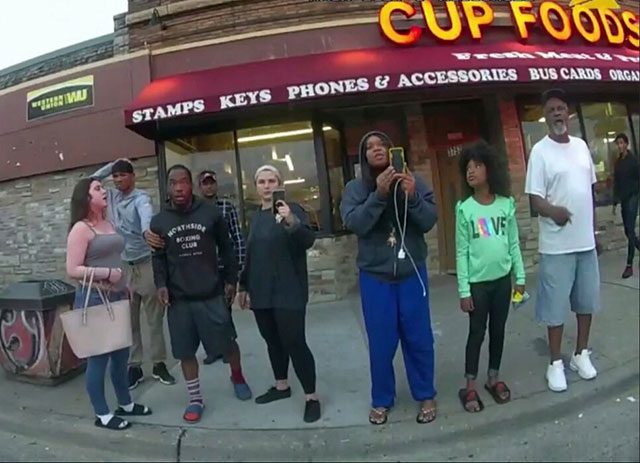
Daniella Frazier bravely filming the police murder of George Floyd. In a statement she posted on the anniversary, she wrote: “A year ago today I witnessed a murder. The victim’s name was George Floyd.... It made me realize how dangerous it is to be Black in America..... If it weren’t for my video, the world wouldn’t have known the truth.... These officers shouldn’t get to decide if someone gets to live or not.” (Photo: Minneapolis Police Department)
Once the testimony got underway, the first week was focused on those who witnessed the murder of George Floyd last May. This included 18-year-old Darnella Frazier, who filmed the famous video of Chauvin kneeling on Floyd’s neck. Frazier had acted incredibly cool-headedly and bravely: she walked her nine-year-old cousin into the store, out of harm’s way, then came back to film at a discreet distance. She said she feels awful she didn’t intervene to save Floyd’s life, but there is no way she could have with four cops all joining in the murder – and it was her video that sent millions of people into the streets to protest. What a country: where parents of black children have “the conversation,” telling young men not to run from cops, no sudden moves, when stopped driving to keep their hands at the “10 and 2” position on the steering wheel – and a 17-year-old knows the protocol about filming a police murder in progress.
Today, Darnella Frazier is hailed as a hero, which she totally is. Ramsey Orta, who filmed the NYPD chokehold murder of Eric Garner in 2014, was not so lucky. In retribution for his courageous act, he was viciously pursued by the cops and sent to prison for four years on weapons charges (he was only released last year).
During the testimony, it was revealed that Chauvin had at least 18 prior complaints on his record. One of his defense lawyers’ ploys was to claim that Floyd had supposedly died of drug-induced cardiac arrest. Floyd’s girlfriend, Courteney Ross, testified about her and his addiction to opioids. But the medical evidence showed only small amounts in his system, and the doctor who treated Floyd at the Hennepin County Medical Center testified that Floyd’s cause of death was “asphyxia,” with complicating factors of “law enforcement subdual, restraint and neck compression.” Another expert testified that a knee to the neck for nine minutes could kill anyone, and that Floyd showed no signs of drug overdose.
The best Chauvin’s cynical defense team could do to bolster their case was to bring in David Fowler, former chief medical examiner for the state of Maryland, who claimed that hypertension and carbon monoxide from the cop car exhaust could have been a contributing factor. He was forced to admit under cross-examination that he had not seen any data suggesting carbon monoxide poisoning played a role. Fowler himself is the defendant in a federal civil rights lawsuit for violating forensic pathology principles in attempting to cover up police responsibility for the death of 19-year-old Anton Black, killed by a cop in Greensboro, Maryland in 2018. The defense also tried to blame an “aggressive crowd” that was demanding that Chauvin stop kneeling on Floyd, suggesting that this could have “distracted” the killer.
The prosecution portrayed Chauvin as a rogue cop who violated proper police procedure. Minneapolis Police Department (MPD) officials, trainers and other “experts” lined up to denounce his conduct and show that he is a very “bad apple.” Minneapolis Police Chief Medaria Arradondo criticized Chauvin for kneeling on the neck of a man who was restrained – but did not say that this is unacceptable in all circumstances. The head of MPD training in 2020 criticized Chauvin’s “improvised position.” Chauvin’s immediate supervisor when he killed Floyd also testified against him. A professor at the University of South Carolina said Chauvin’s restraint of Floyd was neither “appropriate” nor “reasonable.” Rarely has the police establishment turned so uniformly against one of its own. They were acutely aware of what a wrong verdict could bring.
So was the defense, which rested after calling only seven witnesses in two days. It didn’t call on Chauvin to testify, since everyone knew that the city could blow the minute he opened his mouth. The prosecution, in turn, didn’t highlight the fact that Chauvin had used neck or head restraints on seven prior occasions, including when he kicked an intoxicated man in the gut and applied neck restraint until the man fell unconscious – but was only disciplined once. No wonder the murderer acted like he could get away with it. But with Floyd’s death, even Chauvin knew that he had to take the fall for the team (“law enforcement”), and the system. He had agreed to plead guilty to third-degree murder (a lesser charge), but this was rejected last June by Trump’s attorney general William Barr, who worried that it would look lenient and inflame protesters.
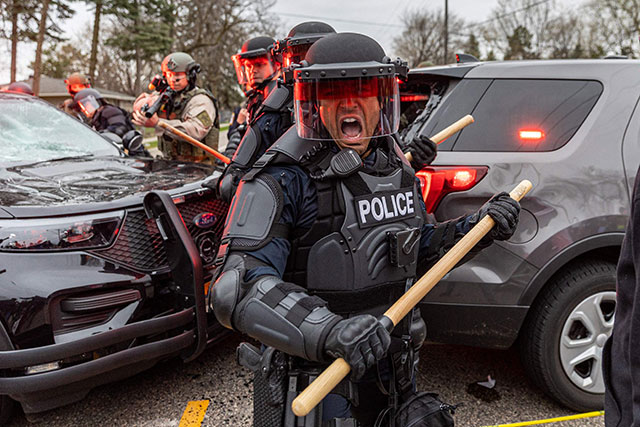
Police attack demonstrators protesting murder of Daunte Wright in Minneapolis suburb of Brooklyn Center, April 11. (Photo: Kerem Yucel / AFP )
But right in the middle of the trial, on April 11, Daunte Wright, a 20-year-old black man, was murdered by police in the Minneapolis suburb of Brooklyn Center, by a cop who “mistakenly” shot him with her gun instead of her taser, after stopping him for expired license plates and an air freshener hanging from the rearview mirror (see “Fury Over Cop Killing of Daunte Wright” on the “Revolutionaries in the Class Struggle” blog). Police violently repressed protests with rubber bullets and tear gas. And on April 15, release of the body-cam footage of the cop who shot Adam Toledo to death revealed that the 13-year-old had his hands up. This recalled the murder of 12-year-old Tamir Rice in 2014 by a Cleveland, Ohio cop. Authorities worried that protests against the upsurge of police violence could derail the well-choreographed Chauvin trial.
With the guilty verdict, the bourgeoisie, its politicians and media breathed a collective sigh of relief. The Minneapolis Star Tribune (20 April) proclaimed it “A Verdict That Must Change America.” From the White House, President Biden declared the trial outcome “a giant step forward in the march toward justice in America.” Speaking for Wall Street, Jamie Dimon, the CEO of JPMorgan Chase, said “justice was served” (CNBC, 21 April). Yet in the 24 hours following the Chauvin verdict, police killed six people across the country, including 16-year-old Ma’Khia Bryant, shot dead by a police officer in Columbus, Ohio, and Andrew Brown, killed by cops in Elizabeth City, North Carolina. Now body-cam footage shows Brown was pulling away from the cops, not driving toward them, disproving their claim of “imminent danger.”
A downtown Minneapolis demonstration of more than 500 people on the evening of April 20, after the Chauvin verdict was announced, was largely celebratory. At the vacant gas station near where the murder took place, which has served as a meeting point for demonstrations, the words “Justice Served” were added to the “Justice for George Floyd” sign, But everyone knows the conviction of one killer cop won’t stop racist police murder. In local opinion polls, over 90% supported the guilty verdict, but only a bare majority of both black and white respondents said it gave them more confidence in the criminal justice system. For now, the Democrats are praising the black police chief Arradondo, the black prosecutor Jerry Blackwell (a private lawyer who has represented 3M, General Mills and Walmart) and black Democratic Farmer-Labor (DFL) Party attorney general Keith Ellison, hoping that some identity politics will keep the lid on.
But a few “black faces in high places” does not change the system, and all of these are part of the capitalist police apparatus. The Attorney General is the state’s “top cop,” as now vice president Kamala Harris described herself when she was the California AG (her specialty was keeping people in prison despite proof of innocence). In the state’s closing argument, another of the prosecutors defended the “noble profession” of policing, and emphasized that “this is not an anti-police prosecution … it’s a pro-police prosecution.” By parading “good” cops before the jury, the state is trying to send the message that the problem is “bad cops” like Chauvin, not the police as a whole and the system of exploitation and rampant inequality they exist to defend. The “law enforcement community” (forces of repression) closed ranks and gave up one of their guard dogs, in in order to reduce the heat on the rest.
The Myth of Police Reform
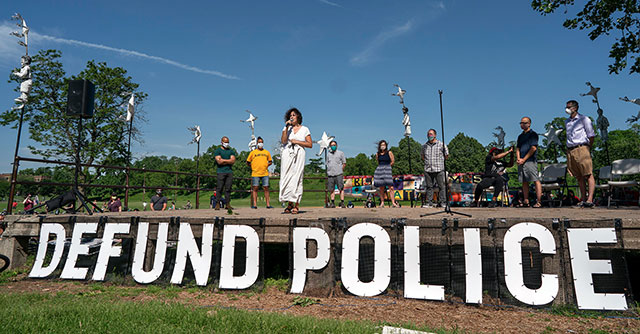
At June 7 rally in Minneapolis' Powderhorn Park, a veto-proof majority of the City Council vowed they would dismantle the police department. Result: zero. (Photo: Jerry Holt / Star Tribune )
Last summer, we wrote that, “In Minneapolis, virtually every one of the police ‘reforms’ that have been bandied about in the U.S. have been tried, and failed” (“To Uproot Racist Oppression: Socialist Revolution,” The Internationalist No. 60, May-July 2020). That included the liberal-utopian call to “abolish the police.” Two weeks after George Floyd was murdered, a veto-proof majority of the Minneapolis city council (which is entirely Democratic except for a lone Green) got up on a stage at Powderhorn Park to announce that they were going to “dismantle” the city’s police department. Instead, they kicked the hot button issue to the voters, putting forward a ballot measure to replace the police with a “Department of Community Safety and Violence Prevention” – which, of course, would still be a police agency, just with a different name.
But even this didn’t make it to a vote, as the city councilors then sent the ballot initiative to a judge-appointed Minneapolis Charter Commission, which in August asked for an additional 90 days to consider the measure. This ensured that it would not be on the ballot in November. The obscure commission has no power to veto such a measure, but it did serve as a convenient device to block it. So what started out as a supposedly radical change to the Minneapolis police became by December a paltry $8 million budget cut (less than 5% of the total MPD budget). Still, some Democrats tried to spin this as a win. Ilhan Omar (DFL), the U.S. Representative for Minnesota's 5th Congressional District and a member of the Democratic “Squad” that has been the targets of vicious right-wing hate propaganda and death threats, tweeted that the budget cut constituted “transformative change.” Hardly.
In the talk of dismantling the police, Camden, New Jersey, was often cited as an example. In 2012, that city disbanded its police force, but then replaced it with county police. Far from ending racist police repression, the number of cops patrolling the city shot up from 268 to 418. Closer to home in Minnesota, the Brooklyn Center and Brooklyn Park police were hailed as a “police reform model” by the Star Tribune (3 August 2020). Since 2005, those police departments had a “Joint Community Police Partnership,” which produced an “embedded community liaison” and a “Multicultural Advisory Committee” in each. But no “partnership,” liaison or advisory committee prevented the murder of Daunte Wright by a Brooklyn Center cop, or stopped police from shooting at protesters with rubber bullets and tear gassing hundreds protesting this murder.
Last June, as the city and country were engulfed with protests, Minneapolis Public Schools voted unanimously to end its relationship with the MPD, which took the form of 14 “school resource officers” (SROs) stationed in public high schools (see “Minneapolis Public Schools Give Cops the Boot,” in The Internationalist No. 60, May-June 2020). At the time, we warned that “replacing the MPD with private security guards or simply another police department will mean back to business as usual.” Just a month later, Minneapolis Public Schools began hiring “private safety support specialists” many of whom were ex-cops. As we wrote then, such private cops must be opposed just as much as the SROs, as part of a larger fight for teacher-student-parent-worker control of the schools.
Across the country there have been a number of state laws and city ordinances passed for police “reform” and “oversight” since George Floyd’s murder (140 by one count). This includes mandating use of body cameras, restricting chokeholds, limiting no-knock warrants, opening police disciplinary records to public scrutiny and eliminating “qualified immunity” of police from civil suits. But none of those measures have made a bit of difference in the systematic racism of the police, any more than enacting “civilian control boards” did in the past. Moreover, attempts to cut police budgets have nearly all failed, or been overturned. Instead, various state legislatures have enacted “back the blue” laws to criminalize protest. In Iowa, “rioting” was made a felony, blocking streets can lead to a year in jail and defacing a statue is now a crime, while drivers who hit and injure protesters were given immunity from civil liability.
Even calls to do away with qualified immunity for police, a centerpiece of the Congressional Democrats’ policing “reform” bill, would have little impact. Where cops have been sued for excessive force, wrongful death and other misconduct, they almost never pay a penny – the municipality, county or state foots the bill. Given the amounts involved ($1.1 billion since 2015 for suits involving NYPD officers; Chicago, $253 million; Los Angeles, $238 million; Minneapolis, $22.3 million) and their frequency, many city governments include anticipated amounts in their annual budgets. Smaller jurisdictions get insurance coverage, like the village of St. Anthony, MN whose $6 million settlement with the family of Philando Castile came from the Minnesota League of Cities. The families deserve every cent they can get – and far more – but the killer cops pay zero, and for the cities that employ them it’s just a “cost of doing business.”
Efforts at police “reform” and “oversight” are inevitably futile, just as cutting the cops’ budget (grandly called “defunding” the police) is ineffectual and dismantling/disbanding/abolishing the police is an illusion. The reason why comes down to the basic Marxist truth that the very purpose of the police is to act as enforcer of the interests of the capitalist class, defending its property and wealth, and upholding its rule over society. As Friedrich Engels wrote in The Family, Private Property and the State (1886), the capitalist state consists of special bodies of “armed men but also of material adjuncts, prisons, and institutions of coercion of all kinds” who serve the economically and politically dominant class in “holding down and exploiting the oppressed class.” Lenin spelled out in The State and Revolution (1917), written on the eve of the Bolshevik Revolution, that “A standing army and police are the chief instruments of state power.” As we wrote during the protests last year:
“And since racial oppression is intrinsic to U.S. capitalism, the liberal/reformist formulas actually mean that the imagined ‘peace officers,’ ‘community police,’ ‘public safety agents’ or whatever they are called, would in fact be maintaining racist, capitalist ‘law and order’.”
–“‘Abolish the Police’ Under Capitalism?” The Internationalist No. 60
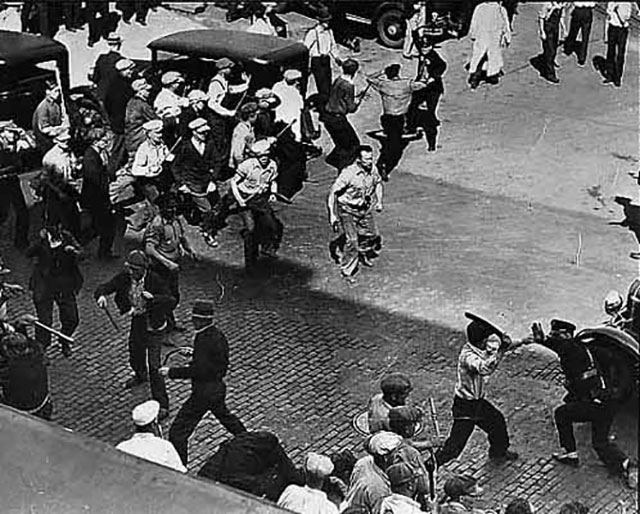
1934 Teamsters strike was met with murderous repression by the Minneapolis police, backed by National Guard. The Trotskyist-led Teamsters responded with militant mass workers action, and won the strike. Seven years later the feds jailed the leaders for their revolutionary opposition to imperialist war. (Photo: Minnesota Historical Society)
The function of the police as the armed fist of the capitalist state was seen concretely in the 1934 Teamsters strike that made Minneapolis a union town. In his classic account, Farrell Dobbs, one of the Trotskyist leaders of the strike, aptly describes the nature of the police:
“Under capitalism the main police function is to break strikes and to repress other forms of protest against the policies of the ruling class. Any civic usefulness other forms of police activity may have, like controlling traffic and summoning ambulances, is strictly incidental to the primary repressive function. Personal inclinations of individual cops do not alter this basic role of the police. All must comply with ruling-class dictates. As a result, police repression becomes one of the most naked forms through which capitalism subordinates human rights to the demands of private property.”
–Farrell Dobbs, Teamster Rebellion (1972)
Minneapolis cops were just as brutal then as today. On 20 July 1934, “Bloody Friday,” 67 people were wounded when police armed with riot guns fired on striking workers. Two were killed, Teamster Henry Ness and an unemployed strike supporter, John Belor. In the face of mounting police/military repression and legal maneuvers, the Trotskyist leadership fought back with mass labor action. And they won the strike.
But eventually the Minneapolis Teamster leaders were ousted by the national union tops, working hand-in-glove with the Democratic administration of Franklin D. Roosevelt, and along with Socialist Workers Party leaders were imprisoned for their revolutionary opposition to the imperialist World War II. If today police strikebreaking is less prominent than cop attacks on antiracist mobilizations, it is because the pro-capitalist union officialdom rarely calls strikes, and when it does it meekly obeys injunctions and prohibitions of effective labor action (mass picketing, flying squads, sit-down strikes), ensuring defeat or at best a standoff, rather than defying the bosses’ anti-labor legal arsenal.
Last summer, bus drivers of Amalgamated Transit Union Local 1005 in Minneapolis refused police orders to transport arrested protesters to jail, as did Transport Workers Union Local 100 in New York City, with the backing of their union leaders. In the Twin Cities, members of several unions also came out to protest the killings of George Floyd last summer, Philando Castille in 2016 and Jamar Clark in 2015. But far more is needed. The next time killer cops strike, unions should shut down the whole metro transit system along with flagship stores of the Minneapolis-based Target and Best Buy chains, plus manufacturing facilities like Medtronics in Brooklyn Center and Fridley, and the 3M Cottage Grove. The point is to hit the capitalists where it hurts.
The Democratic Party would have us believe, as Nancy Pelosi grotesquely said after the Chauvin verdict was announced, that George Floyd “sacrificed his life for justice.” Yet the conviction of one murdering police officer does not alter the system of racist repression that is integral to American capitalism. In reality, just over 1% of killer cops are ever charged (140 out of a total of 13,000 police who have killed civilians since 2005); fewer still are convicted. Repression is what the police do, it can’t be reformed away. In fact, the repressive apparatus has expanded, along with the prison system, and become increasingly militarized as decaying capitalism produces millions of unemployed people and poverty-stricken communities, while the middle class is hollowed out and the tiny layer of mega-capitalists grows more aggressive.
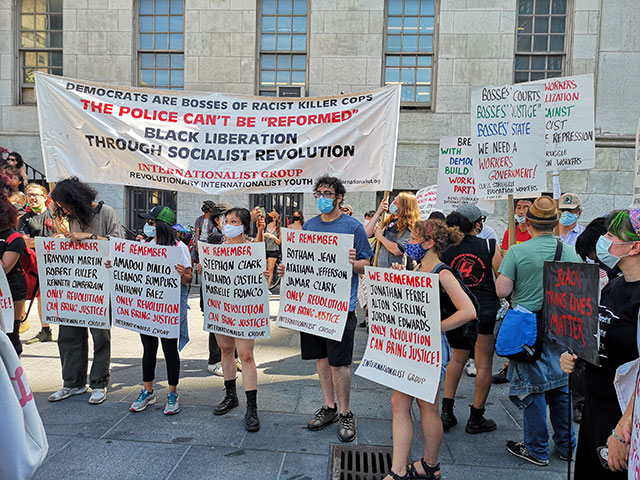
Internationalist contingent in Juneteenth 2020 protest in New York City: “The Police Can’t Be ‘Reformed’.” Minneapolis is proof. Only revolution can bring justice. (Internationalist photo )
Last year, massive protests against racist police brutality were further stoked by indignation against Trump, whose racist comments and threats to use the military fueled the fires of outrage. Now the Democrats are in, but the police murder machine grinds on. To stop it will take nothing less than a revolution to sweep away the capitalist system, and with it, its murderous thugs in blue. As the Internationalist Group/Revolutionary Internationalist Youth banner that we carried last Juneteenth proclaimed, “The Police Can’t Be ‘Reformed’,” and “Democrats Are the Bosses of Racist Killer Cops.” It’s necessary for labor, black people, Latinos, immigrants and all the oppressed to break with the Democratic Party and get started on building the revolutionary workers party that we urgently need to put an end to the unending plague of racist police repression. Black liberation through socialist revolution! ■
- 1. https://fatalencounters.org/.
- 2. https://mappingpoliceviolence.org/.
- 3. https://www.statista.com/statistics/585152/people-shot-to-death-by-us-police-by-race/.
- 4. A 2015 study of the fatalencounters.org data base showed that almost all (95%) of police-caused deaths occur in neighborhoods with less than $100,000 median family incomes (the median income of neighborhoods where 441 police killings occurred was $53,000). See https://www.alternet.org/2015/07/95-police-killings-2015-occurred-neighborhoods-incomes-under-100000/.
